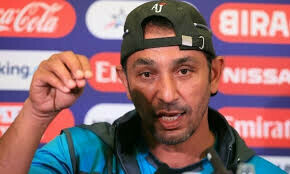Imagine travelling back in time … there you are, sitting in one of the stands of Kensington Oval in Bridgetown, Barbados and there is Wasim Raja sans helmet showing his class and grit as he scores an unbeaten 117 against the deadly West Indian bowling attack. A reggae song plays on some spectator’s pocket radio. Oh, what a spectacle it must have been for those who actually witnessed it happening.
Wasim Raja played most of his cricket in the ‘Bob Marley era’ in which his batting style and demeanor fit like the proverbial glove; reminiscent of Marley, Raja had (still has) a cult following. It was the same era in which the counter-cultural movement (a.k.a the hippie movement) began and withered away. One couldn’t help but imagine that perhaps in the world of cricket, Raja was an adherent of this movement.
Very few people possess that natural swagger and Raja was one of them. In the late 1970s and early ‘80s when Imran Khan became a role model for every second youngster in Pakistan, there were still a few lads who didn’t jump on that bandwagon. Instead, they, especially those who batted left-handed, became cult followers of Raja and started to imitate his mannerism and beard style.
August 23 marks the 11th death anniversary of a cult hero of Pakistan sports
Many thought that his cricket was ahead of his time. Yes, but perhaps it was this very thing which made him so special. At the time, he was unique; one of a kind. He never had a perfect textbook batting stance, but his extra-ordinary hand and eye coordination, along with a high back-lift allowed him to demonstrate his virtuoso batting skills. Never following the norms got him labeled as a ‘rebel’ in Pakistan cricket. Perhaps he could’ve played a lot more international cricket by surrendering his ego in front of the cricket establishment in Pakistan, but then ‘Raja’ was not just a part of his name. Wasim was a Raja in the true sense.
Many former cricketers who played cricket with Raja remember him as an educated and sensitive introvert. At times, some of his captains and team management got irked by his flippant attitude, but Mushtaq Mohammad was an exception. In the 1976-77 Australian tour, despite an impressive hundred against a state side, Raja wasn’t able to secure a place in the Test eleven. He took this exclusion so much to heart that his ‘reaction’ became a ‘disciplinary matter’ for the touring side. It was only due to the intervention of his captain Mushtaq Mohammad, who had the knack for dealing with ‘difficult’ players, that he was retained in the team, which then went to the subsequent tour of the Caribbean.
And it was this 1977 tour of West Indies in which he hit his purple patch. He made four consecutive half centuries in the first two Tests. Batting at number seven he made 117 not out and 71 in the opening Test in Barbados. In the second Test in Trinidad he made another two half centuries with scores of 65 and 84 in two innings. He notched up two more half tons — 70 and 64 in the fourth and fifth Tests played at Queens Park Oval and Kingston respectively — bringing his tally of runs to 517 with a staggering average of 57.44 in the five-match Test series.
Interestingly, the enormity of his performance in the ’77 series can be gauged by the fact that in the previous season, in 1976, the visiting Indian team surrendered one of the Test matches in protest against the ‘intimidating’ West Indian bowling. Raja’s flamboyance with the bat and mettlesome attitude attracted a large number of crowds to the grounds; especially in the Caribbean. And it was no surprise that the man saved his best for cricket fanatics in the West Indies. In all, he played eleven Tests against the West Indian side which had perhaps the greatest fast bowling line-up with the likes of Andy Roberts, Joel Garner, Colin Croft, and Malcolm Marshall.
Wasim Raja and his younger brother Rameez Raja played together in two Tests and four ODIs for Pakistan. In 1985 during the final of the World Championship of Cricket between India and Pakistan — played in Melbourne, Australia — Rameez tumbled on the fence while attempting an impossible catch off his better bowling and got injured. The elder Raja ran towards the long-off fence to console Rameez who was in apparent respiratory distress. Wasim Raja’s worried face and vehement signals to the dressing room for medical help showed his deep love and concern for his younger brother. It was the last time that Wasim Raja represented his country in an international match and subsequently he settled in England to pursue other endeavours.
He breathed his last on August 23, 2006, during a veterans match in Buckinghamshire. But he lives on in the hearts of fans.
The writer tweets @CaughtAtPoint
Published in Dawn, EOS, August 20th, 2017














































